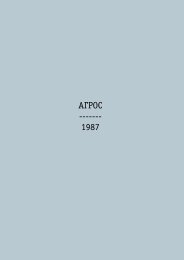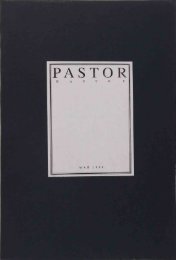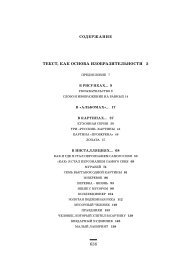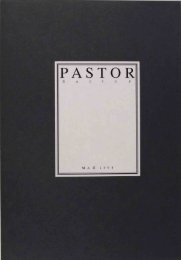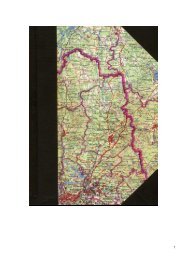А. Монастырский, Н. Панитков, И. Макаревич, Е. Елагина, С ...
А. Монастырский, Н. Панитков, И. Макаревич, Е. Елагина, С ...
А. Монастырский, Н. Панитков, И. Макаревич, Е. Елагина, С ...
Create successful ePaper yourself
Turn your PDF publications into a flip-book with our unique Google optimized e-Paper software.
audience, and separated the participants (S.H., A.M. and S.R.) from viewers. Inside the box, invisible to<br />
the audience, there was a working tape recorder with a 45-minute-long tape. It was empty, with three<br />
occasional technical noises like clicks and humming: in the middle of the recording there was a sound of<br />
rewinding tape (about one minute long) and in the beginning and the end there were a couple of button<br />
clicks.<br />
Behind participants‘ backs in a windowpane there was a square black box (also used in the "Voices"<br />
action) with three electric torches of different shapes protruding from it (for description of these electric<br />
torches see text "Engineer Wasser and engineer Licht").<br />
In the room there were several black boards with letters and numbers, like those on car license plates.<br />
Moscow<br />
6 th of February, 1985<br />
A.Monastyrski, S.Hangsen, S.Romashko<br />
Viewers:<br />
I.Kabakov, I.Bakshtein, I.Nakhova, Yu.Leiderman, A.Zhigalov, N.Abalakova, D.Prigov, V.Mochalova,<br />
L.Rubinstein, G.Witte, E.Dobringer, S.Letov + 3 persons<br />
37. JUPITER (4.33)<br />
In the room where the action lasting 4 houres and 33 minutes took place, besides usual house interior<br />
there were six black shields on the walls with emblematic images of paralinguistic signs. These included:<br />
1) "Time" – a man looking at wrist watch; 2) "Wipe your ears" or "Stop your ears" - a man with fingers<br />
stuck into his ears; 3) "Fifty-fifty" – a one-eyed man; 4) "Yes" – a man with naked teeth; 5) "No" – a man<br />
with a black hole instead of mouth; 6) "No" – a man with hanging out tongue.<br />
The paralinguistic meaning of last four emblems is optional and only possible in the sequence with first<br />
conventional two. A shield with "twinkling man" split the emblematic sequence into semantic (1,2,3 – to<br />
½) and emotional (3 - to ½, 4,5,6). Besides these shields, there was also a rectangular black box with four<br />
turned-on electric torches on the windowpane and a square black box with 3 electric torches (used in the<br />
"Translation" action) on the shelf. During the live musical performance only these lights and a table lamp<br />
were lit. In the pauses (during playback of recordings) the ceiling light was switched on.<br />
The action consisted of a series of musical improvisations with a common "minimalist" theme, in which<br />
the following performers took part: A.Monastyrski (pianoforte), S.Letov (fagotto), S.Romashko (endblown<br />
flute and triple-tone whistle) and S.Haensgen (cross flute). Besides them, pre-recorded tapes were<br />
used in the course of action. Two of them – "The Duet" by S.Letov and A.Monastyrski and "The Trio" by<br />
S.Letov, S.Haensgen and A.Monastyrski – were played back during the pauses; they were recorded prior<br />
to the action and consisted of improvisation to one theme. Another phonogram titled "The Trains; The<br />
Barrel" (recorded by A.Monastyrski in an area near train station "Yauza") occasionally overlapped the<br />
live performance. It consisted of noises of passing-by trains melting into half-hour long sound of a barrel<br />
rolling down an asphalt road. Besides instruments and phonograms, a TV set sitting on the piano was also<br />
used during the action as a source of light, sound and images. Also on the piano, on the right from the TV<br />
set there were large headphones used by Monastyrski to repeat after TV news broadcast "Vremya"<br />
(Time). On the piano‘s music stand there was a glass-sided black sheet of paper with a sticker in its center<br />
saying "C.A. Jupiter (4.33)".<br />
The action was carried out according to the following scheme (timekeeping was supervised by<br />
G.Kizewalter who imposed phonograms over the live sound to signal either the gradual termination of<br />
live playing or beginning of a new stage of musical performance):<br />
1. 18:00 – 18:10 – Phonogram "The Duet". TV is off.<br />
A.: 18:10 – 18:55 – the first 45-minutes-long stage of live performance. TV is off. Phonogram "The<br />
Trains; The Barrel" is not used.<br />
2. 18:55 – 19:05 – Phonogram "The Trio". TV is off.<br />
B.: 19:05 – 19:50 – The second 45-minutes-long stage of live performance. TV is on, displaying clear<br />
white screen without sound. First 45 minutes of phonogram "The Trains; The Barrel" are played back.




